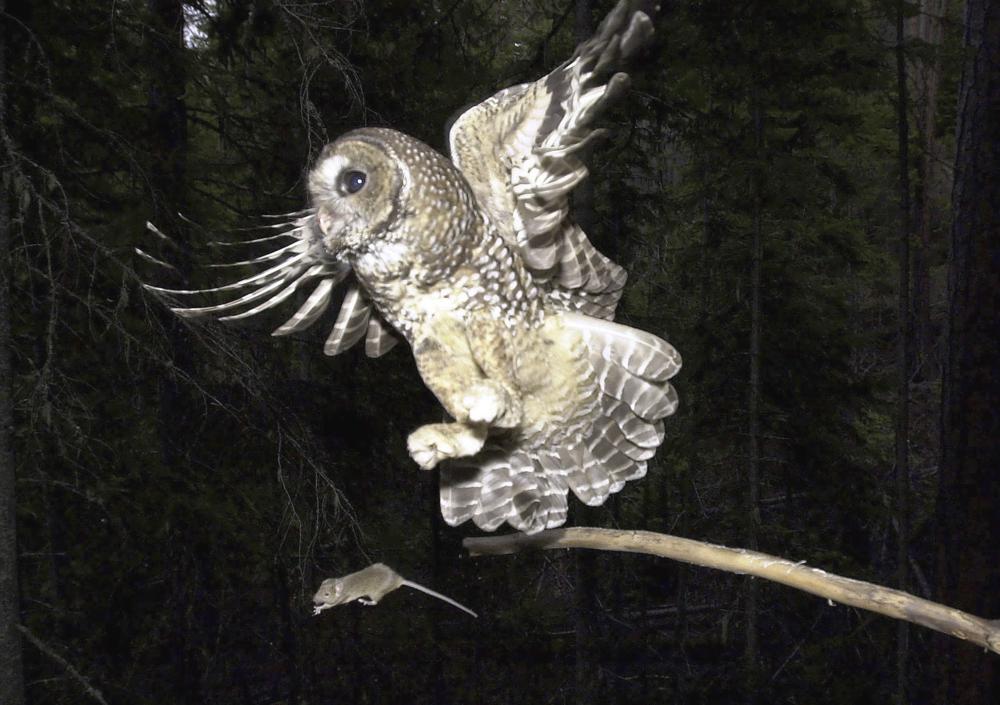FILE – In this May 8, 2003, file photo, a Northern Spotted Owl flies after an elusive mouse jumping off the end of a stick in the Deschutes National Forest near Camp Sherman, Ore. The Trump administration has slashed more than 3 million acres of protected habitat for the northern spotted owl in Oregon, Washington and northern California, much of it in prime timber locations in Oregon’s coastal ranges. Environmentalists are accusing the U.S. Fish and Wildlife Service under President Donald Trump of taking a “parting shot” at protections designed to help restore the threatened owl species. (AP Photo/Don Ryan, File)
PORTLAND, Ore. (AP) — Political appointees in the Trump administration relied on faulty science to justify stripping habitat protections for the imperiled northern spotted owl, U.S. wildlife officials said Tuesday as they struck down a rule that would have opened millions of acres of forest in Oregon, Washington and California to potential logging.
The U.S. Fish and Wildlife Service reversed a decision made five days before Trump left office to drastically shrink so-called critical habitat for the spotted owl. The small, reclusive bird has been in decline for decades as old-growth forests disappear.
The Associated Press obtained details on Tuesday’s action prior to it being made public.
Government biologists objected to the changes under Trump and warned they would put the spotted owl on a path to extinction, documents show.
But Trump’s Interior Secretary David Bernhardt and former Fish and Wildlife Service Director Aurelia Skipwith dismissed those concerns — instead adopting a plan to lift restrictions on more land than even the timber industry had sought.
Officials said in documents provided to AP that Bernhardt and Skipwith underestimated the threat of extinction and relied on a “faulty interpretation of the science” to reach their decision.
Bernhardt defended his handling of the matter, telling AP in an email that Congress gave the interior secretary authority to exclude areas from protection.
Bernhardt said the agency’s “reasonable certainty” the owl would go extinct did not meet the law’s requirement that habitat be protected lest a species “will” go extinct.
If wildlife officials want to change that standard, Bernhardt added, “they should seek a change from Congress.”
“Any future Secretary can weigh the benefit factors differently, but they can not change the law or the legal standard,” Bernhardt wrote, adding his January rule was “consistent with the existing law.”
Officials twice delayed the changes after President Joe Biden took office and they never went into effect. That puts them among numerous Trump-era policies reversed or struck down by the Interior Department in recent months on issues ranging from oil and gas drilling on some public lands to protections for birds from wind farms.
Democratic lawmakers from Oregon, Washington and California in February called for an investigation into the removal of spotted owl protections, citing “potential scientific meddling” by Trump appointees.
Wildlife advocates, government agencies and the timber industry have sparred for decades over the spotted owl, which has seen population declines of 50% or more in Oregon and Washington since 1995.
Federal habitat protections imposed in 2012 were meant to avert the bird’s extinction, but have been blamed for a slowdown in logging that’s devastated some rural communities.
Of 9.6 million protected acres (3.9 million hectares), federal officials initially proposed in August 2020 to remove protections for about 2%.
The timber industry said the plan didn’t go far enough and called for removal of more than 28%. In January, Skipwith abruptly changed her agency’s recommendation and went even further, telling Bernhardt more than one-third of the protected land, or almost 3.5 million acres (1.4 million hectares), should be excluded from protection.
The land has huge swaths of timber and includes 2 million acres (809,000 hectares) spread in a checkerboard pattern across western Oregon.
Logging those lands might not have killed off the owls immediately — they live up to 20 years on territories that can stretch across 10,000 acres (4,000 hectares) per owl — yet eventually they would have gone extinct, said Paul Henson, the wildlife service’s Oregon supervisor.
Henson brought his concerns to superiors, but Skipwith overrode them.
“You can’t remove over a third of an endangered species’ habitat and not expect it to go extinct,” Henson said in an interview. “There wasn’t much disagreement about the science. The disagreement was how much that risk constrains the secretary’s authority” to remove habitat protections.
The logging industry says more thinning and management of protected forests is necessary to support timber jobs and prevent wildfires, which devastated 560 square miles (1,450 square kilometers) of spotted owl habitat last fall. Of that, about 300 square miles (777 square kilometers) is no longer considered viable for the birds.
Timber interests also say some of the land set aside under Tuesday’s rule isn’t actually spotted owl habitat or is broken up into parcels too small to support the owl. As such, the smaller habitat designation issued under Trump was “legally and scientifically valid,” said Nick Smith, a spokesman for the American Forest Research Council. The group represents about 100 manufacturing and logging operations in five western U.S. states.
“The federal government cannot set aside critical habitat unless it is habitat for the species. That’s the critical concern for us,” he said.
The logging industry says the larger, non-native barred owl is a much greater threat than logging. Skipwith echoed that contention when she said the most effective way to preserve spotted owls was to control barred owl numbers.
“The main threats faced by the Northern Spotted Owl are the barred owl and the devastating forest fires,” Skipwith said, adding that she used sound science to reach her conclusion. “It’s not an issue of acreage; it’s an issue of the management of the land.”
The barred owls, native to the eastern U.S., began affecting spotted owl numbers in Washington and Oregon about a decade ago as they expanded their range west and south, Henson said.
Beginning in 2013, fish and wildlife biologists studied the impact of barred owl removal in four areas of northern California home to the smaller spotted owl. The pilot program, which wrapped up in August, showed spotted owl numbers stabilized when barred owl numbers were reduced. It continued to decline in areas without the removals.
Study authors cautioned that the results show habitat protections are also critical to the spotted owl’s survival.
In rejecting the Trump rule, federal officials said the dual threats of wildfires and competition from the barred owl underscore why more forest needs protection — to make sure there’s enough “redundancy” of habitat that a large fire won’t doom the species.
A large-scale barred owl removal program is not in place and officials said the best science shows protecting older forests is critical.
Environmental groups cheered Tuesday’s move but expressed frustration that about 200,000 acres (about 81,000 hectares) of previously protected habitat were excluded from the new rule.
“In the past 20 years, there’s been accelerated loss of old-growth forest on state and private lands so it’s continued to lose habitat,” said Noah Greenwald, endangered species director for the Center for Biological Diversity. Climate change adds to the threats faced by forests, he said.
In December, wildlife officials said continued declines in owl populations mean the owl merits a more critical listing as “endangered.”
The agency refused to do so immediately, saying other species took higher priority. That decision is facing a legal challenge.
Brown reported from Billings, Montana
Copyright 2021 Associated Press. All rights reserved.








































